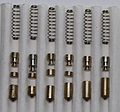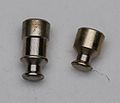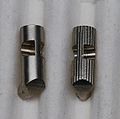ASSA Twin Combi
ASSA Twin Combi (5800)
| ASSA Twin Combi | |
 | |
| Name | ASSA Twin Combi |
|---|---|
| Manufacturer | ASSA |
| Lock Type | Cylinder |
| Lock Design | Pin-tumbler, Sidebar |
| Year(s) Produced | 1991-present[1] |
| Related Locks | |
| ASSA Twin 6000 ASSA Twin Exclusive ASSA Twin Maximum ASSA Twin Pro ASSA Twin V-10 | |
The Twin Combi (or Combi, Max, Twin Multi, Twin 5800) is a pin-tumbler lock made by ASSA. The Combi is part of the Twin series of locks that use pin-tumblers and a sidebar to provide two layers of security. The sidebar in the Combi is the first in the Twin series (historically) to require that finger pins be raised and rotated properly. Later systems that include this principle are the ASSA Twin V-10 and the ASSA Twin Maximum.
The Combi is similar in function to the Schlage Primus cylinder.
Principles of operation
The Combi uses six pin-tumblers and five sidebar finger pins. The top (driver) pins use single and double-spool designs. Counter-milling in the plug chambers works with the spool pins and provides a high level of pick resistance. There are 9 depths available for bottom (key) pins, and four depths available for top (driver) pins. Top and bottom pins are combined to provide a balanced (uniform height) pin stack that resists attack from decoding, comb picks, and reduces wear on the springs. In total, there are 531,441 (96) theoretical key differs for the pin-tumbler portion of the lock.
The sidebar, located in the 8 o'clock position, is pushed out by two springs. The sidebar bitting on the key raises finger pins which interface with the sidebar. Pins must be raised and rotated properly for the sidebar to retract. Finger pins can be positioned in two heights and three rotations for a total of 7,776 (25*35) theoretical sidebar differs. Manipulation resistance for finger pins is provided in the form of serrated pins, with serrations running vertically down the entire pin.
The cylinder and plug use a variety of hardened steel inserts to protect against forced entry. In the plug, steel rods are located at the 9, 12, and 3 o'clock positions. In the cylinder, three rods are located in front of the pin chambers at the 12 o'clock position. Rods near the third pin chamber in the plug and cylinder are also common.
Notes
- The Twin 1800 is a less expensive form of the Combi that uses fewer (3) sidebar pins.
- The pin-tumbler bitting code is referred to as the system code, and the sidebar bitting code as the sidebar code.
Disassembly instructions
The Combi is disassembled in the same way as a traditional pin-tumbler cylinder. The sidebar does not cause too many problems when the plug is removed. When the key is removed from the exposed plug the finger pins will be forced out by spring pressure.
- Remove the cam or C-clip.
- Insert the key and turn the plug 45-90 degrees.
- Withdraw the plug from the cylinder. (A plug follower is recommended)
OR
- Remove the chamber casings and take out each pin-stack individually
- Remove the cam or C-clip.
- Withdraw the plug from the cylinder.
Vulnerabilities
The Combi system may be vulnerable to one or more of the following:
Notes
- Bumping is possible given a bump key with the correct sidebar bitting.






